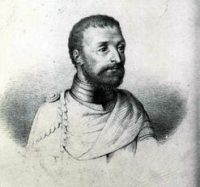El lunes 8 de septiembre largamos el ancla cerca del muelle de Sevilla, y descargamos toda nuestra artillería.
El martes bajamos todos a tierra en camisa y a pie descalzo, con un cirio en la mano, para visitar la iglesia de Nuestra Señora de la Victoria y la de Santa María la Antigua, como lo habíamos prometido hacer en los momentos de angustia.
De Sevilla partí para Valladolid, donde presenté a la Sacra Majestad de don Carlos, no oro ni plata, sino cosas que eran a sus ojos mucho más preciosas. Entre otros objetos, le obsequié un libro escrito de mi mano, en el cual había apuntado día por día todo lo que nos había acontecido durante el viaje.
Abandoné Valladolid lo más pronto que me fue posible y me fui a Portugal para hacer relación al rey don Juan de las cosas que acababa de ver. Pasando en seguida por España fui a Francia, donde regalé algunas cosas del otro hemisferio a Madama la Regente, madre del rey muy católico Francisco I.
Regresé al fin a Italia, donde me consagré para siempre al muy excelente y muy ilustre señor Felipe Villiers de l’Isle-Adam, gran maestre de Rodas, a quien di también la relación de mi viaje.
El caballero
ANTONIO PIGAFETTA
[Fin]
[206] On Monday, 8 September, we cast anchor near the quay of Seville, and discharged all our artillery.
[207] Tuesday, we all went in shirts and barefoot, each holding a candle, to visit the shrine of Santa Maria de la Victoria, and that of Santa Maria de Antigua.
[208] Leaving Seville, I went to Valladolid, where I presented to his sacred Majesty, Don Carlo, neither gold nor silver, but things worthy to be very highly esteemed by such a sovereign. Among other things, I gave him a book, written by my hand, concerning all the matters that had occurred from day to day during our voyage. I left there as best I could and went to Portugal, where I spoke with King Dom João of what I had seen. Passing through Spain, I went to France, where I made a gift of certain things from the other hemisphere to the mother of the most Christian king, Don Francis, Madame the Regent. Then I came to Italy, where I devoted myself forever, and these my poor labours, to the famous and most illustrious Lord Philippe de Villiers l’Isle-Adam, the most worthy Grand Master of Rhodes.
The Knight
Antonio Pigafetta
[The Journal of Antonio Pigafetta ends here.]
Noong araw ng Lunes, ikawalo ng Setyembre, nagbaba kami ng angkla malápit sa daungan ng Seviglia, at pinaputok ang lahat ng aming kanyon. Pagka-Martes, pumasok kaming lahat na nakakamiseta at nakayapak, may hawak na kandila ang bawat isa, upang dalawin ang dambana ni Santa Maria de la Victoria at ni Santa Maria de l’Antiqua.
Pagkaalis ng Seviglia, nagtúngo ako sa Vagliadolit kung saan ko inihandog sa kaniyang banal na kamahalan, Don Carlos, hindi ang bulawan o ang pilak, kung hindi ang mga bagay na lubos na pinahahalagahan ng isang hari. Isa sa mga ito ang isang aklat, na sinulat ng aking kamay, tungkol sa lahat ng pangyayaring naganap araw-araw sa aming paglalakbay. Umalis ako doon sa abot ng aking makakaya at nagtúngo sa Portugalo kung saan ko ibinahagi kay Haring Don Johanni ang aking mga nakita. Dumaan ako ng España at tumúngo sa Francia kung saan naghandog ng regalo ng ilang bagay mula sa kabilâng hati ng mundo sa ina ng pinaka-Kristiyanong hari, si Don Francisco, ang Madam ang Rehente. Pagkatapos ay nagtúngo ako sa Italia kung saan ko habambuhay na inihandog ang aking sarili at itong aking mga abáng pagsisikap para sa tanyag at pinakabantog na lakan, si Philip de Villiers Lisleadam, ang pinaka-karapat-dapat na grand master ng Rhodes.
Ang Kabalyero
ANTONIO PIGAFETTA
[Wakas]
